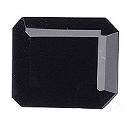|
ClassicGems.net |
|
|
 |
|
Allanite-(Ce) |
|
|
Discovered in 1810; IMA status: Valid (pre-IMA; Grandfathered) |
|||
|
|
|
Chemistry |
|
|
|
|
|
(Ca;Ce)2(Al;Fe2+;Fe3+)3(SiO4)(Si2O7)O(OH) |
|
|
|
Calcium Cerium Yttrium Aluminum Iron Silicate Hydroxide |
|
Molecular Weight: |
614.71 gm |
|
Composition: |
Calcium |
3.91 % |
Ca |
5.47 % |
CaO |
|
|
Cerium |
27.35 % |
Ce |
32.04 % |
Ce2O3 |
|
|
Yttrium |
4.34 % |
Y |
5.51 % |
Y2O3 |
|
|
Aluminum |
9.88 % |
Al |
18.66 % |
Al2O3 |
|
|
Iron |
6.81 % |
Fe |
9.74 % |
Fe2O3 |
|
|
Silicon |
13.71 % |
Si |
29.32 % |
SiO2 |
|
|
Hydrogen |
0.16 % |
H |
1.47 % |
H2O |
|
|
Oxygen |
33.84 % |
O |
|
|
|
|
|
100.00 % |
|
100.00 % |
= TOTAL OXIDE |
|
|
|
||||
|
Classification |
|
|
|
|
|
Silicates (Germanates) |
|
|
8/C.23-80 |
|
|
|
9 : SILICATES (Germanates)
|
|
Related to: |
Epidote Group |
|
Members of Group: |
Epidote Group: Allanite, Askagenite, Clinozoisite, Dissakisite, Dollaseite, Epidote, Ferriallanite, Khristovite, Manganiandrosite, Manganipiemontite, Mukhinite, Piemontite, Uedaite, Vanadoandrosite, Zoisite |
|
Varieties: |
Chromian Allanite-(Ce), Allanite-(Ce), Allanite-(La), Allanite-(Y) |
|
Synonyms: |
Cerepidote, Cerine, Cerorthite |
|
|
|
|
Crystal Data |
|
|
|
|
|
Monoclinic - Prismatic (may be metamict - a mineral originally crystalline, eventually amorphous due to radiation damage) |
|
|
Crystals tabular, or prismatic to acicular, to 90 cm; granular, massive. |
|
|
Polysynthetic, common on [100] |
|
|
|
|
|
Physical Properties |
|
|
|
|
|
Imperfect on [001], Poor on [100], Poor on [110] |
|
|
Irregular/Uneven, Conchoidal |
|
|
Brittle |
|
|
5.5 - 6.0 |
|
|
3.50 - 4.20 (g/cm3) |
|
|
None |
|
|
Weak; GRapi = 27,438.55 (Gamma Ray American Petroleum Institute Units) |
|
|
|
|
|
Optical Properties |
|
|
|
|
|
Black, dark Brown, dark Reddish Brown, dark Greenish Brown |
|
|
Translucent to Opaque |
|
|
Vitreous, Resinous to Sub-Metallic |
|
|
1.715 - 1.822 Biaxial ( - ); Metamict Allanites are isotropic with N as low as 1.61 |
|
|
0.018 - 0.031 |
|
|
Distinct to Strong; r > v |
|
|
X = pale olive-green, reddish brown; Y = dark brown, brownish yellow; Z = dark reddish brown, greenish brown |
|
|
|
|
|
Occurances |
|
|
|
|
|
Geological Setting: |
An accessory in some granites and granite pegmatites, syenites, more rarely in gabbroic pegmatites. Rarely in schists, gneisses, and some contact metamorphosed limestones; a clastic component of sediments. |
|
Common Associations: |
Epidote, Fluorite, Muscovite |
|
Common Impurities: |
None |
|
Type Locality: |
Aluk Island, Prins Christian Sound, Kitaa (West Greenland) Province, Greenland |
|
Year Discovered: |
1810 |
|
View mineral photos: |
|
|
|
|
|
Unusual Gem Categories |
|
|
|
|
|
|
|
|
More Information |
|
|
|
|
|
|
|
|
|
|
|
Allanite-(Ce) is a rare member of the Epidote Group of minerals that includes Allanite, Clinozoisite, Epidote, Hancockite, Mukhinite, Piedmontite, Tanzanite, Thulite and Zoisite. Allanite is usually opaque black but may also be found as light to dark brown or greenish brown crystals. The black, opaque crystals are usually larger and the transparent brownish crystals are usually too small for faceting. Because Allanite is a weakly radioactive mineral it should be stored away from other gems and minerals that are subject to damage from radioactivity and of course human exposure should be limited. Allanite is usually metamict due to the presence of radioactive Cerium (Ce) in its chemical composition. Metamictization is a natural, gradual process of destruction of the internal crystal structure of a mineral due to radiation present in the mineral or from nearby external radiation. Metamictization eventually leaves the mineral amorphous or without any internal crystal structure. Once this process is complete the mineral is described as metamict. Allanite was named in 1810 by British chemist and mineralogist Thomas Thomson (1773-1852) to honor Scottish mineralogist Thomas Allan (1777-1833), who first observed the mineral. Allanite is found at many locations worldwide. Some locations for good crystals follow. From Qáqarssuatsiaq, Alluk, south Greenland. At Ytterby and Finbo, Sweden. From Kragerö, Arendal, and on Hitterö Island, Flekkefjord, Norway. From Sillböle, Stansvik, and Vaarala, Finland. At Miass, Ilmen Mountains, Southern Ural Mountains, Russia. From the Trimouns talc deposit, six km northeast of Luzenac, Ariμege, France. In the USA, at Pacoima Canyon, Los Angeles County, California; in the Baringer Hill pegmatite, 26 km west of Burnet, and on the Rode Ranch, Llano County, Texas. In Canada, from Olden Township, Frontenac County, Quebec; in the McDonald mine, Hybla, Ontario; and at Hoidas Lake, near Nisikkatch Lake, Saskatchewan. From near Telixtlahuaca, Oaxaca, Mexico. In the Mary Kathleen mine, Queensland, and at Broken Hill, New South Wales, Australia. From Ribuae, Mozambique. |
|
|
Allanite gems for sale: We have not photographed the Allanite gems yet. Please check back soon. |